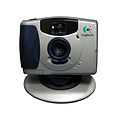| Camera | Model # | Part # | Image | Year | Category | Sensor resolution | Focus | RRP (USD) | Notes |
|---|
| Connectix QuickCam | | | | 1994 | General | 320 × 240 4bpp Greyscale | | $100 | Sold over 500,000 units from 1994 to 1997. [4] Serial model with built-in microphone and Parallel model. [5] |
| Connectix Color QuickCam | | | | 1996 | General | 320 × 240 24bpp | | $199 | Serial model with built-in microphone and Parallel model. [5] |
| Connectix Color QuickCam 2 | | | | 1997 | General | 320 × 240 24bpp | | $199 | Improved sensor and optical system, optimised for indoor use [4] Parallel model only. [5] |
| Connectix QuickCam VC | | |  | 1998 | General | 320 × 240 | | $99 – $129 | VC for "Video Conferencing". First USB QuickCam; also supports parallel ports. [6] |
| Connectix QuickCam Home | | | | 1998 | General | 320 × 240 [7] | | $130 | Only USB. [8] |
| Connectix QuickCam Pro | | | | 1998 | High-End | 640 × 480 | | $150 | USB and Parallel. [8] |
| Logitech USB QuickCam Home | | |  | 1998 | General | 352x288 [9] | | | |
| Logitech QuickCam Express | | |  | 1999 | General | 320 × 240 @ 30 frame/s, [10] 640 × 480 @ 15 frame/s | | $49 | . [8] |
| Logitech QuickCam Web | | | | 1999 | High-End | 640 × 480 @ 30 frame/s [11] | | | Only USB. [12] With built-in microphone. [13] |
| Logitech QuickCam Pro 3000 | | | | 2000 | High-End | 640 × 480 | | | |
| Logitech QuickCam 3000 | | | | 2001 | Business | 640 × 480 | | [14] |
| Logitech QuickCam Traveler | | |  | 2001 | Notebook | 640 × 480 @ 30 frame/s [15] | | $99 – $149 | First "laptop" QuickCam. [16] |
| Logitech QuickCam for Notebooks | | 961404-0403 | | 2001 | Notebook | 640 × 480 video, 640 × 480 still photo | Manual | | |
| Logitech QuickCam for Notebooks Pro | | 961398-0403 | | 2001 | Notebook | 1.3 Mpixel resolution | | | RealLight lighting correction. f=3.85 mm |
| Logitech QuickCam Pro 4000 | | |  | 2002 | High-End | 640 × 480 @ 15 frame/s [17] | | | Can take interpolated 1280 × 960 stills. |
| Logitech QuickCam Zoom | | | | 2002 | General | 640 × 480 | | $99 | Features a digital zoom that focuses on the user's face. Re-released as "QuickCam Zoom Silver" in 2003, then "QuickCam Zoom Refresh" in 2004. |
| Logitech QuickCam Sphere | | | | 2003 | Flagship | 640 × 480 | | | First motorised pan/tilt QuickCam. Known as "QuickCam Orbit" in North America |
| Logitech QuickCam Messenger | | | | 2004 | General | | | | |
| Logitech QuickCam Express 2 | | | | 2004 | General | | | | |
| Logitech QuickCam Communicate MP | | 997-000078 960-000240 | | 2004 | General | 960 × 720 video, 4.0 Mpixel still photo | Fixed | | 183 cm USB cord. Adjusts lighting in dim light. |
| Logitech QuickCam Cordless | | | | 2004 | Speciality | | | | |
| Logitech QuickCam for Notebooks Deluxe | V-UBU49 | 860-000070 960-000095 |  | 2005 | Notebook | 640 × 480 video, 1.3 Mpixel still photo | Manual | | 78 cm USB cord |
| Logitech QuickCam Chat | | | | 2005 | General | | Manual | | |
| Logitech QuickCam Fusion | | | | 2005 | General | | | | |
| Logitech QuickCam Pro 5000 | | | | 2005 | High-End | | | | |
| Logitech QuickCam Sphere MP | | | | 2005 | Flagship | 640 × 480 | | | Motorized pan/tilt. Known as the "QuickCam Orbit MP" in North America |
| Logitech QuickCam Ultra Vision | | | | 2005 | High-End | 640 × 480 @ 30 frame/s | | | |
| Logitech QuickCam Connect | | | | 2006 | General | 640 × 480 [18] video, 640 × 480 still photo | | | |
| Logitech QuickCam Communicate STX | V-UBK45 V-UAM14A | 961410-0403 961443-0403 961464-0403 961687-0403 | | 2006 | General | 640 × 480 @ 30 frame/s, 1.3 Mpixel still photo | Fixed | | |
| Logitech 720p Webcam C905 | V-UBU48 | 860-000108 |  | 2007 | Notebook/General | 1600 × 1200 video, 8.0 Mpixel still photo | Auto | | 78 cm USB cord. Comes with 30 weighted base and mounting stalk. RightLight2 lighting correction. |
| Logitech QuickCam Pro 9000 | V-UBM46 | 860-000109 960-000313 |  | 2007 | High-End | 1600 × 1200 @ 30 frame/s video, 8.0 Mpixel still photo | Auto | | 210 cm cord |
| Logitech QuickCam IM | | | | 2007 | General | 640 × 480 | | | |
| Logitech QuickCam Sphere AF | | | | 2007 | Flagship | 1600 × 1200 | | | Known as "QuickCam Orbit AF" in North America. |
| Logitech QuickCam Vision Pro | | 960-000254 | | 2008 | Macintosh | 1600 × 1200 | Auto | | |







